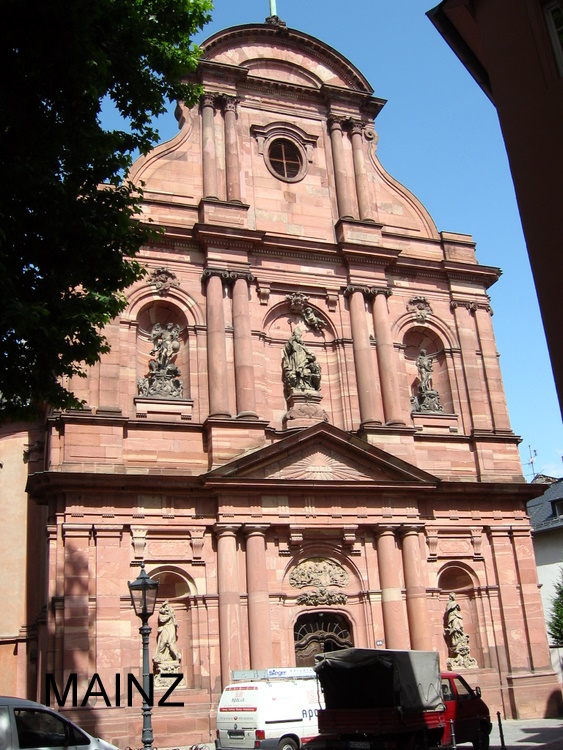CATHEDRAL QUEST
Our quest to experience the great cathedrals and churches of Europe
BAROQUE ARCHITECTURE
1600-1750
The word Baroque literally means a "misshapen pearl". This period of architecture was called Baroque because some considered the style very odd. Baroque architecture evolved out of Renaissance architecture in Italy. The two main architects of the Baroque era were Bernini and Borromini. Bernini's first medium was sculpture. He liked to incorporate a lot of sculpture into his buildings. A sculptor and mason, Francesco Burromini went to Rome in 1614, and trained under Bernini.
Late Roman buildings, particularly St. Peter's Basilica, may be considered precursors to Baroque architecture, as the design achieves a colossal unity that was previously unknown. In the 1600's, the Renaissance architects began to get bored with the symmetry and same old forms they had been using for the past 200 years. They started to make bold, curving, unsymmetrical buildings, with ornate decorations.

 The facades consisted of many curves,
often using the double curve (in at the sides, out in the middle). Baroque
pediments (triangular area between the rooftop and the end of the roofs) were
often highly decorated. The tips were sometimes turned into scrolls and gilded
. In these two examples, St. Moise in Venice (on the right) has a more
ornate facade than does St. Ignatius in Mainz, Germany; however the interior of
St. Ignatius is almost Rococo.
The facades consisted of many curves,
often using the double curve (in at the sides, out in the middle). Baroque
pediments (triangular area between the rooftop and the end of the roofs) were
often highly decorated. The tips were sometimes turned into scrolls and gilded
. In these two examples, St. Moise in Venice (on the right) has a more
ornate facade than does St. Ignatius in Mainz, Germany; however the interior of
St. Ignatius is almost Rococo.
The most distinct shape of the Baroque
style is the oval. The baroque
architects used marble, gilt, and bronze in abundance on the interior. One often
finds the interiors surrounded by numerous gilded puttos (little angels) as well
as some life sized ones.
The
ceilings and domes often contained large frescos or murals using what is known as
"Trompe l'oeil"
painting which is an art technique involving extremely realistic imagery in
order to create the optical illusion that the depicted objects appear in three
dimensions, instead of actually being a two-dimensional painting.
The walls are often highly painted
The Baroque played into the demand for
an architecture that was on the one hand more accessible to the emotions and, on
the other hand, a visible statement of the wealth and power of the Church. By
the middle of the 17th century, the Baroque style had found its secular
expression in the form of grand palaces, first in France and then throughout
Europe.
The
Baroque style became more restrained in France. While lavish details were used,
French buildings were usually symmetrical and orderly. The Palace of Versailles is an outstanding example. Baroque
archi tecture emerged in England after the Great Fire of London in 1666.
Architect Christopher Wren used restrained Baroque styling when he helped
rebuild the city, his most famous accomplishment was St.
Paul's Cathedral
(on the right).
tecture emerged in England after the Great Fire of London in 1666.
Architect Christopher Wren used restrained Baroque styling when he helped
rebuild the city, his most famous accomplishment was St.
Paul's Cathedral
(on the right).
Builders in Spain, Mexico, and South America combined Baroque ideas with exuberant sculptures, Moorish details, and extreme contrasts between light and dark. Spanish Baroque architecture was used through the mid-1700s, and continued to be imitated much later. In Germany, Austria, Eastern Europe, and Russia, Baroque ideas were often applied with a lighter touch. Pale colors and curving shell shapes gave buildings the delicate appearance of a frosted cake. The term Rococo was used to describe these softer versions of the Baroque style.
Below
is a list of the Baroque churches that we have visited.
As I write about these churches on the various travel pages, I will
provide a link from the church listed below to a full description of that
particular church.
This chart is presently not updated.
|
|
|
BAROQUE 1600-1750
|
|
|
Started
|
Finished
|
City
|
Country
|
Church Name
|
|
|
1500 |
Venice |
Italy |
San Salvador |
13th century |
1534 |
Venice |
Italy |
San Francesco della Vigna |
|
|
1542 |
Venice |
Italy |
San Sebastiano |
|
|
1577 |
Venice |
Italy |
Il Redentore |
1600
|
|
Venice
|
Italy
|
St. Moise
|
1618
|
|
Cologne
|
Germany
|
St. Maria
Himmelfahrt
|
1625
|
|
Paris
|
France
|
St. Nicolas du
Chardonett
|
1625
|
|
Rome
|
Italy
|
Santa Maria de
Montesanto
|
1631
|
1681
|
Venice
|
Italy
|
Santa Maria della Salute
|
1646
|
|
Paris
|
France
|
St. Sulpice
|
1672
|
|
Venice
|
Italy
|
San Maria
di Giglio
|
1673
|
1710
|
London
|
England
|
St. Paul's
|
1675
|
|
Rome
|
Italy
|
Santa Maria de
Miracoli
|
1677
|
|
Paris
|
France
|
Dome/Soldiers
Church
|
1704
|
|
Venice
|
Italy
|
San Stae
|
1743
|
|
Venice
|
Italy
|
Santa Maria del Rosario
|
1754
|
|
Padua
|
Italy
|
Cathedral
|
1763
|
|
Mainz
|
Germany
|
St. Ignatius
|
1768
|
|
Mainz
|
Germany
|
St. Augustine
|
1771
|
1775
|
Florence
|
Italy
|
Santa Maria delle
Carmine
|
1804
|
|
Venice
|
Italy
|
San Polo
|
|
|
|
|
|
|
|
|
|
|
|
|
|
|


